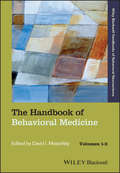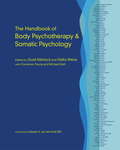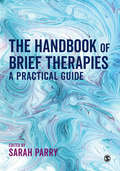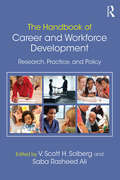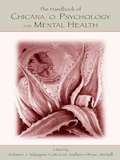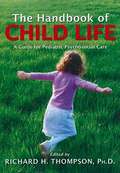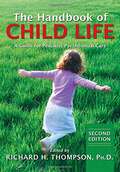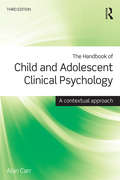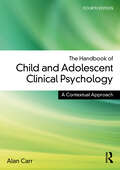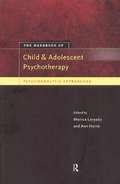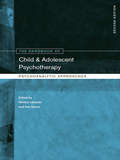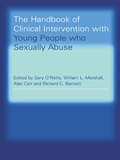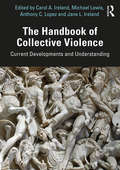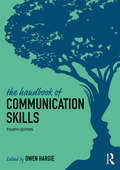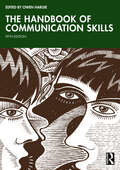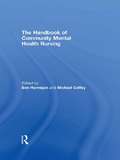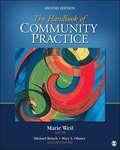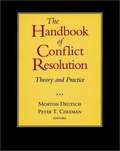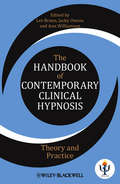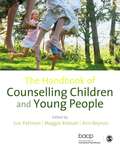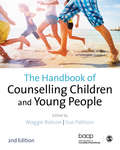- Table View
- List View
The Handbook of Behavioral Medicine (Blackwell Handbooks of Behavioral Neuroscience)
by David I. MostofskyHandbook of Behavioral Medicine presents a comprehensive overview of the current use of behavioral science techniques in the prevention, diagnosis, and treatment of various health related disorders. Features contributions from a variety of internationally recognized experts in behavioral medicine and related fields Includes authors from education, social work, and physical therapy Addresses foundational issues in behavioral medicine in Volume 1, including concepts, theories, treatments, doctor/patient relationships, common medical problems, behavioral technologies, assessment, and methodologies Focuses on medical interface in Volume 2, including issues relating to health disorders and specialties; social work, medical sociology, and psychosocial aspects; and topics relating to education and health 2 Volumes
The Handbook of Body Psychotherapy and Somatic Psychology
by Halko Weiss Gustl Marlock Courtenay Young Michael SothThe Handbook of Body Psychotherapy and Somatic Psychology provides a comprehensive overview of body-centered psychotherapies, which stress the centrality of the body to overcoming psychological distress, trauma, and mental illness. Psychologists and therapists are increasingly incorporating these somatic or body-oriented therapies into their practices, making mind-body connections that enable them to provide better care for their clients. Designed as a standard text for somatic psychology courses, The Handbook of Body Psychotherapy and Somatic Psychology contains 100 cutting-edge essays and studies by respected professionals from around the world on such topics as the historical roots of Body Psychotherapy; the role of the body in developmental psychology; the therapeutic relationship in Body Psychotherapy; and much more, as well as helpful case studies and essays on the use of Body Psychotherapy for specific disorders. This anthology will be indispensible for students of clinical and counseling psychology, somatic psychology, and various forms of body-based therapy (including dance and movement therapies), and is also an essential reference work for most practicing psychotherapists, regardless of their therapeutic orientation.Contributors: Gustl Marlock, Halko Weiss, Courtenay Young, Michael Soth, Ulfried Geuter, Judyth O. Weaver, Wolf E. Büntig, Nicholas Bassal, Michael Coster Heller, Heike Langfeld, Dagmar Rellensmann, Don Hanlon Johnson, Christian Gottwald, Andreas Wehowsky, Gregory J. Johanson, David Boadella, Alexander Lowen, Ian J. Grand, Marilyn Morgan, Stanley Keleman, Eugene T. Gendlin, Marion N. Hendricks-Gendlin, Michael Harrer, Ian J. Grand, Marianne Bentzen, Andreas Sartory, George Downing, Andreas Wehowsky, Marti Glenn, Ed Tronick, Bruce Perry, Susan Aposhyan, Mark Ludwig, Ute-Christiane Bräuer, Ron Kurtz, Christine Caldwell, Albert Pesso, Michael Randolph, William F. Cornell, Richard A. Heckler, Gill Westland, Lisbeth Marcher, Erik Jarlnaes, Kirstine Münster, Tilmann Moser, Frank Röhricht, Ulfried Geuter, Norbert Schrauth, Ilse Schmidt-Zimmermann, Peter Geissler, Ebba Boyesen, Peter Freudl, James Kepner, Dawn Bhat, Jacqueline Carleton, Ian Macnaughton, Peter A. Levine, Stanley Keleman, Narelle McKenzie, Jack Lee Rosenberg, Beverly Kitaen Morse, Angela Belz-Knöferl, Lily Anagnostopoulou, William F. Cornell, Guy Tonella, Sasha Dmochowski, Asaf Rolef Ben-Shahar, Jacqueline A. Carleton, Manfred Thielen, Xavier Serrano Hortelano, Pat Ogden, Kekuni Minton, Thomas Harms, Nicole Gäbler, John May, Rob Fisher, Eva R. Reich, Judyth O. Weaver, Barnaby B. Barratt, Sabine Trautmann-Voigt, Wiltrud Krauss-Kogan, Ilana Rubenfeld, Camilla Griggers, Serge K. D. Sulz, Nossrat Peseschkian, Linda H. Krier, Jessica Moore Britt, and Daniel P. Brown.From the Hardcover edition.
The Handbook of Brief Therapies: A practical guide
by Dr Sarah L ParryThis step-by-step guidebook offers a range of contemporary and popular brief treatments, suitable for a range of client groups and professional settings. Following a comprehensive introduction to the use of brief interventions in therapeutic practice, each chapter provides an introduction to the theoretical underpinnings and evidence-based brief intervention, followed by guidance on how to implement the approaches with useful 'top tips', worksheets and examples from practice through case vignettes illustrating its application. Includes chapters on motivational interviewing, brief interventions for suicide risk, brief and single-session exposure-based therapies for phobias and PTSD, solution-focused brief therapy, brief interventions for violence, brief interventions for psychosis and a selection of special interest feature chapters (e.g. supporting people through bereavement and nurturing wellbeing in hospital settings). The Handbook is an essential guide to a range of practitioners working across a multitude of fields within health, social care and education. The Handbook reflects current recommendations and guidelines of the National Institute for Health and Care Excellence and recommendations of accrediting professional bodies in the UK and US. A must have for any practitioner working to support the wellbeing of others.
The Handbook of Brief Therapies: A practical guide
by Sarah ParryThis step-by-step guidebook offers a range of contemporary and popular brief treatments, suitable for a range of client groups and professional settings. Following a comprehensive introduction to the use of brief interventions in therapeutic practice, each chapter provides an introduction to the theoretical underpinnings and evidence-based brief intervention, followed by guidance on how to implement the approaches with useful ′top tips′, worksheets and examples from practice through case vignettes illustrating its application. The Handbook reflects current recommendations and guidelines of the National Institute for Health and Care Excellence and recommendations of accrediting professional bodies in the UK and US. A must have for any practitioner working to support the wellbeing of others.
The Handbook of Career and Workforce Development: Research, Practice, and Policy
by Saba Rasheed Ali V. Scott H. SolbergThe Handbook of Career and Workforce Development provides educators, researchers, and policy makers with information on evidence-based programs and activities. Chapters describe ways that current research can be used to promote the design of more effective career development programs and services at local, state, and national levels. Promising career development practices applicable to a range of settings and special populations are identified, as are strategies for communicating evidence in ways that influence career and workforce development public policy. The Handbook of Career and Workforce Development can be used by policy makers and grant program officers to identify key career development ingredients that should be considered in proposals; researchers seeking to make their career development research relevant and practical; and practitioners implementing or advocating for career development programs and services.
The Handbook of Chicana/o Psychology and Mental Health
by Brian W. McNeill Roberto J. Velásquez Leticia M. ArellanoMexican-Americans now constitute two thirds of what has become the largest and fastest-growing minority group in the United States, Hispanics. They have distinct cultural patterns and values that those who seek to serve them competently as clinicians and educators, and those who attempt to study them, need to understand. This is the first comprehensive overview of the psychology of the Chicana/o experience since 1984. Solidly grounded in the latest theory and research, much of which is relevant to other Latina/o groups as well, The Handbook of Chicana/o Psychology and Mental Health is an indispensable source of up-to-date information and guidance for mental health and education professionals, their trainees and students; and for social and behavioral scientists interested in the impact of cultural differences in multicultural settings.
The Handbook of Child Life: A Guide for Pediatric Psychosocial Care
by Richard H. ThompsonIt has been said that the moral test of a society is how it treats its most vulnerable citizens. Those who enter the field of child life daily encounter those in our society who are among the most vulnerable . . . vulnerable because of their age and their ways of interpreting the world, vulnerable because of their physical circumstances, vulnerable because of the unfamiliar they encounter, vulnerable at times because of additional barriers such as language, poverty or prejudice. Yet, the child life specialist understands that each individual, despite the vulnerabilities he or she may bring to an encounter, also brings strength and resiliency. The task of the child life specialist is to build upon those strengths and to minimize individual vulnerability and maximize the growth of the individual. This book addresses the most important aspects of the practice of child life. The book is geared toward an audience beyond the introductory level and includes information on the state of the art in each chapter covered. Wherever possible, the book demonstrates application of the contents in practice through case studies. The goal of this text is to assist in this process, drawing upon the expertise of leading figures in the field to help provide child life specialists, and other allied health professionals, with the knowledge and skills they will need to accomplish this important task. Book jacket.
The Handbook of Child Life: A Guide for Pediatric Psychosocial Care
by Richard H. ThompsonRevised edition of The handbook of child life, c2009. <p>Child life is a profession that draws on the insights of history, sociology, anthropology and psychology to serve children and families in many critical stress points in their lives, but especially when they are ill, injured or disabled and encounter the hosts of caregivers and institutions that collaborate to make them well. Children and their families can become overwhelmed by the task of understanding and navigating the healthcare environment and continue to face challenges through their daily encounters. It is the job of child life professionals to provide care and guidance in these negotiations to serve as culture brokers, interpreters of the healthcare apparatus to family and child and the child to medical professionals. Despite the best efforts to provide quality, sensitive psychosocial care to children and their families, they remain vulnerable to lingering aftereffects. <p><p>The goal of this revised edition is to help prepare child life specialists to deliver the highest level of care to children and families in the context of these changing realities. Each chapter has been substantially revised and two new chapters have been added. This book will be a valuable resource for not only child life specialists but also nurses, occupational and recreational therapists, social workers and other hospital personnel.
The Handbook of Child and Adolescent Clinical Psychology: A Contextual Approach
by Alan CarrThe third edition of the hugely successful Handbook of Child and Adolescent Clinical Psychology incorporates important advances in the field to provide a reliable and accessible resource for clinical psychologists. Beginning with a set of general conceptual frameworks for practice, the book gives specific guidance on the management of problems commonly encountered in clinical work with children and adolescents drawing on the best practice in the fields of clinical psychology and family therapy. In six sections thorough and comprehensive coverage of the following areas is provided: Frameworks for practice Problems of infancy and early childhood Problems of middle childhood Problems of adolescence Child abuse Adjustment to major life transitions Thoroughly updated throughout, each chapter dealing with specific clinical problems includes cases examples and detailed discussion of diagnosis, classification, epidemiology and clinical features. New material includes the latest advances in: child and adolescent clinical psychology; developmental psychology and developmental psychopathology; assessment and treatment programmes. This book is invaluable as both a reference work for experienced practitioners and as an up-to-date, evidence-based practice manual for clinical psychologists in training. The Handbook of Child and Adolescent Clinical Psychology is one of a set of 3 books published by Routledge which includes The Handbook of Adult Clinical Psychology: An Evidence Based Practice Approach, Second Edition (Edited by Carr & McNulty) and The Handbook of Intellectual Disability and Clinical Psychology Practice (Edited by Alan Carr, Christine Linehan, Gary O’Reilly, Patricia Noonan Walsh and John McEvoy).
The Handbook of Child and Adolescent Clinical Psychology: A Contextual Approach
by Alan CarrNow in its fourth edition, The Handbook of Child and Adolescent Clinical Psychology incorporates important advances in the field to provide a practice- oriented and accessible resource for clinical psychologists in training.Beginning with a set of general conceptual frameworks for practice, the book gives specific guidance on the management of problems commonly encountered in clinical work with children and adolescents, drawing on the best practice in the fields of clinical psychology and family therapy. There is comprehensive coverage of Problems of infancy and early childhood Problems of middle childhood Problems of adolescence Child abuse Adjustment to major life transitions including entering foster care, parental divorce, and bereavement Each chapter dealing with specific clinical problems includes cases examples; discussion of diagnosis, classification, epidemiology, clinical features, assessment, and treatment; and practice exercises. New material includes the latest advances in child and adolescent clinical psychology assessment and treatment programmes and positive psychology. It also is updated in line with the latest revisions of ICD and DSM.This book is invaluable as both a reference work for experienced practitioners and as an up-to-date, evidence- based practice manual for clinical psychologists in training.
The Handbook of Child and Adolescent Psychotherapy: Psychoanalytic Approaches
by Ann Horne Monica LanyadoThis Handbook provides a comprehensive guide to the practice and principles of child and adolescent psychotherapy around the world.Contents include:* a brief introduction to the child psychotherapy profession, its history and development* a review of the theory underlying therapeutic practice* an overview of the varied settings in which child psychotherapists work* analysis of the growth of the profession internationally* an examination of areas of expertise around the world * a summary of current researchContributors are experienced practitioners from within a diverse range of schools and approaches and so provide a well-rounded picture of child and adolescent psychotherapy today. The Handbook of Child and Adolescent Psychotherapy will be an essential resource for professional psychotherapists, students of psychotherapy, social workers and all professionals working with disturbed children.
The Handbook of Child and Adolescent Psychotherapy: Psychoanalytic Approaches
by Monica LanyadoThis updated edition of The Handbook of Child and Adolescent Psychotherapy reflects the many changes in the profession. It includes: additional chapters on neuroscience, work with ‘looked after children’ and with foster parents, working in schools enlarged chapters on research, attachment theory, work with parents, and developments in child and adolescent psychotherapy around the world chapters on areas of specialist interest including violence, sexual abuse and abusing, trauma, parent-infant psychotherapy, autism, victims of political violence, delinquency and gender dysphoria. The Handbook remains accessible and jargon-free. It will be a valuable resource for all who work in allied professions where the emotional well-being of children is of concern – health, education, social services – as well as trainee psychotherapists and experienced practitioners.
The Handbook of Clinical Intervention with Young People who Sexually Abuse
by Alan Carr William L. Marshall Richard Beckett Gary O’ ReillyThe Handbook of Clinical Interventions with Young People who Sexually Abuse provides authoritative, critical and up-to-date reviews of the growing body of empirical and theoretical knowledge in this field and clearly demonstrates how this knowledge can be used to guide and develop evidence-based practice for assessment and treatment. Key features include:* essentials of effective treatment programmes* relapse prevention* adolescents with intellectual disabilities and female offenders* work with families of young people who sexually abuse. Practical guidelines from acknowledged international experts with extensive experience of research and clinical practice will be invaluable to all those working with young people who engage in sexually abusive behaviour.
The Handbook of Collective Violence: Current Developments and Understanding
by Michael Lewis Carol A. Ireland Jane L. Ireland Anthony LopezThe first of its kind, The Handbook of Collective Violence covers a range of contexts in which collective violence occurs, bringing together international perspectives from psychology, criminology and sociology into one complete volume. There have been significant advances made in the last 25 years regarding how collective violence is conceptualised and understood, with a move away from focusing on solely individual forms of violence toward examining and understanding violence that can occur within groups. This handbook presents some of the most interesting topics within the area of collective violence, drawing upon international expertise and including some of the most well-known academics and practitioners of our generation. Structured into four parts: understanding war; terrorism; public order and organized violent crime; and gang and multiple offender groups, this volume provides academics and practitioners with an up-to-date resource that covers core areas of interest and application. Accessibly written, it is ideal for both academics and policymakers alike, capturing developments in the field and offering a deep theoretical insight to enhance our understanding of how such collective violence evolves, alongside practical suggestions for management, prevention and intervention.
The Handbook of Communication Skills
by Owen HargieThe Handbook of Communication Skills is recognised as one of the core texts in the field of communication, offering a state-of-the-art overview of this rapidly evolving field of study. This comprehensively revised and updated fourth edition arrives at a time when the realm of interpersonal communication has attracted immense attention. Recent research showing the potency of communication skills for success in many walks of life has stimulated considerable interest in this area, both from academic researchers, and from practitioners whose day-to-day work is so dependent on effective social skills. Covering topics such as non-verbal behaviour, listening, negotiation and persuasion, the book situates communication in a range of different contexts, from interacting in groups to the counselling interview. Based on the core tenet that interpersonal communication can be conceptualised as a form of skilled activity, and including new chapters on cognitive behavioural therapy and coaching and mentoring, this new edition also places communication in context with advances in digital technology. The Handbook of Communication Skills represents the most significant single contribution to the literature in this domain. Providing a rich mine of information for the neophyte and practising professional, it is perfect for use in a variety of contexts, from theoretical mainstream communication modules on degree programmes to vocational courses in health, business and education. With contributions from an internationally renowned range of scholars, this is the definitive text for students, researchers and professionals alike.
The Handbook of Communication Skills
by Owen HargieThe Handbook of Communication Skills is recognised as one of the core texts in the field of communication, offering a state-of-the-art overview of this rapidly evolving field of study.The fifth edition of this bestselling book situates communication in a range of different contexts, from interacting in groups to the counselling interview. It covers topics such as non-verbal behaviour, listening, negotiation, interacting in groups and mentoring. This new edition has been fully revised and updated and includes a brand new chapter on digitally mediated communications in social and working environments, as well as newly written chapters on humour and laughter in communication, and persuasion. Based on the core tenet that interpersonal communication can be conceptualised as a form of skilled activity, the book looks at core communication skills and how these can be applied in specific contexts, expertly combining theory with practice.This handbook provides a rich mine of information for use in a variety of contexts, from theoretical mainstream communication modules on degree programmes to vocational courses in health, business and education. With contributions from an internationally renowned range of scholars, this is the definitive text for students, researchers and professionals alike.
The Handbook of Community Mental Health Nursing
by Michael Coffey Ben HanniganThis handbook brings together authoritative contributions from leading mental health researchers, educators and practitioners to provide a comprehensive text for community mental health nurses in training and practice. In thirty-three chapters it covers a wide range of topics, from the history of the profession to current approaches to specific client groups, organised around three linked themes: professional context practice issues education and research. Each chapter includes a summary of key points and suggestions for further reading, and also includes useful appendices listing key professional and voluntary organisations, journals, Internet and mailing lists.The handbook reflects the diversity and scope of the role of the CMHN and recognizes the multidisciplinary and service user context in which nurses work. It is an essential text for CMHNs and mental health nurse educators, and offers a useful source of reference for allied professionals.
The Handbook of Community Practice
by Marie Weil Mary L. Ohmer Michael ReischThe Second Edition of The Handbook of Community Practice is expanded and updated with a major global focus and serves as a comprehensive guidebook of community practice grounded in social justice and human rights. It utilizes community and practice theories and encompasses community development, organizing, planning, social change, policy practice, program development, service coordination, organizational cultural competency, and community-based research in relation to global poverty and community empowerment. This is also the first community practice text to provide combined and in-depth treatment of globalization and international development practice issues--including impacts on communities in the United States and on international development work. The Handbook is grounded in participatory and empowerment practices, including social change, social and economic development, feminist practice, community-collaborative, and engagement in diverse communities. It utilizes the social development perspective and employs analyses of persistent poverty, asset development, policy practice, and community research approaches as well as providing strategies for advocacy and social and legislative action. The handbook consists of forty chapters which challenge readers to examine and assess practice, theory, and research methods. As it expands on models and approaches, delineates emerging issues, and connects policy and practice, the book provides vision and strategies for local to global community practice in the coming decades. The handbook will continue to stand as the central text and reference for comprehensive community practice, and will be useful for years to come as it emphasizes direction for positive change, new developments in community approaches, and focuses attention on globalization, human rights, and social justice. It will continue to be used as a core text for multiple courses within programs, will have long term application for students of community practice, and will provide practitioners with new grounding for development, planning, organizing, and empowerment and social change work.
The Handbook of Complex Trauma and Dissociation in Children: Theory, Research, and Clinical Applications
by Ana M. Gómez Jillian HoseyThe Handbook of Complex Trauma and Dissociation in Children: Theory, Research, and Clinical Applications is a comprehensive and truly vital text for both experienced professionals and novice clinicians alike. In these pages, dozens of experts and pioneers thoroughly cover the complex nuances of theory, assessment, research, and clinical practice. Specific sections cover etiology, neurobiology, and various theoretical and conceptual models for working with the complexities of cumulative and chronic traumatization in childhood.Additional sections cover standardized and non-standardized assessment and diagnostic tools, as well as the formulation and organization of the clinical interview with children and caregivers. Other chapters provide systematic and comprehensive reviews of current treatment modalities and effective approaches for treating children with complex trauma and dissociation across different stages of early development. The book’s co-editors bookend the volume with thorough explorations of the nuanced and multifaceted issues impacting children with complex trauma and dissociative symptoms and features.
The Handbook of Conflict Resolution
by Peter T. ColemanCreated under the direction of Morton Deutsch, a founder of the field of conflict resolution, The Handbook of Conflict Resolution is a compendium of knowledge from a stellar panel of experts.
The Handbook of Contemporary Clinical Hypnosis
by Les Brann Ann Williamson Jacky OwensCovering theory and practice, The Handbook of Contemporary Clinical Hypnosis is an up-to-date, authoritative resource to support health professionals in their use of hypnosis in clinical settings. Provides an authoritative new reference for practitioners and trainees on the diverse applications of hypnosis, published under the auspices of the British Society for Clinical and Academic Hypnosis (BSCAH)Combines a theoretical framework with material on a wide range of specific disorders including anxiety, stress phobias, eczema, oncology, eating disorders and infertilityShows how to adjust hypnotic techniques for different contexts e.g. when working with children, in emergencies and via a translator Features a variety of case studies that illustrate hypnosis techniques in action
The Handbook of Counselling Children & Young People
by Sue Pattison Ann Beynon Maggie RobsonThis landmark handbook brings together the fundamentals of counselling children and young people theory, research, skills and practice. It addresses what every successful trainee or practitioner needs to know in a way that is comprehensive, accessible and jargon-free. Divided into four parts, it covers: theory and practice approaches, including chapters on child development, person-centred, psychodynamic, CBT, Gestalt approaches, and more counselling process, including chapters on the therapeutic relationship, skills, groupwork, supervision practice issues, including chapters on law and policy, ethics, diversity, challenging behaviour practice settings, including chapters on health and social care settings, school and education, multi-agency and collaboration. Each chapter includes a chapter introduction and summary, reflective questions and activities, helping trainees to cement their learning. With chapters contributed by leading experts and academics in the field, this book is essential reading for trainees and practitioners working with children and young people.
The Handbook of Counselling Children & Young People
by Sue Pattison Ann Beynon Maggie RobsonThis landmark handbook brings together the fundamentals of counselling children and young people theory, research, skills and practice. It addresses what every successful trainee or practitioner needs to know in a way that is comprehensive, accessible and jargon-free. Divided into four parts, it covers: theory and practice approaches, including chapters on child development, person-centred, psychodynamic, CBT, Gestalt approaches, and more counselling process, including chapters on the therapeutic relationship, skills, groupwork, supervision practice issues, including chapters on law and policy, ethics, diversity, challenging behaviour practice settings, including chapters on health and social care settings, school and education, multi-agency and collaboration. Each chapter includes a chapter introduction and summary, reflective questions and activities, helping trainees to cement their learning. With chapters contributed by leading experts and academics in the field, this book is essential reading for trainees and practitioners working with children and young people.
The Handbook of Counselling Children & Young People
by Sue Pattison Maggie RobsonExpert authors from a wide range of backgrounds bring together the fundamentals of counselling practice with children and young people in this landmark handbook. It covers all your students need to know about theory and practice approaches, the counselling process, and practice issues and settings. This second edition is updated with the latest developments and research in an ever-changing field, and includes new content on: Diversity and difference Mental illness Safeguarding and risk assessment Child and young people's development Attachment theory and application Each chapter includes a chapter introduction and summary, reflective questions and activities, helping trainees to cement their learning. With chapters contributed by leading specialists and academics in the field, this book is essential reading for trainees and practitioners working with children and young people.
The Handbook of Counselling Children & Young People
by Sue Pattison Maggie RobsonExpert authors from a wide range of backgrounds bring together the fundamentals of counselling practice with children and young people in this landmark handbook. It covers all your students need to know about theory and practice approaches, the counselling process, and practice issues and settings. This second edition is updated with the latest developments and research in an ever-changing field, and includes new content on: Diversity and difference Mental illness Safeguarding and risk assessment Child and young people's development Attachment theory and application Each chapter includes a chapter introduction and summary, reflective questions and activities, helping trainees to cement their learning. With chapters contributed by leading specialists and academics in the field, this book is essential reading for trainees and practitioners working with children and young people.
